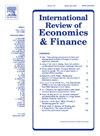数字经济对区域税收的空间溢出效应——基于衰减边界和溢出路径的实证研究
IF 4.8
2区 经济学
Q1 BUSINESS, FINANCE
引用次数: 0
摘要
利用2012 - 2022年中国省级面板数据,构建空间德宾模型进行实证分析,数字经济的发展不仅有效促进了地方税收的增长,而且对周边地区的税收产生了积极的空间溢出效应。进一步分析发现,随着地理距离的不断增加,空间溢出效应呈现逐渐衰减的特征,当地理距离超过500 km时,溢出效应不再显著。路径分析表明,技术市场的发展和外资的流入是数字经济实现空间溢出的主要途径。异质性分析表明,数字经济对区域税收的促进作用在创新能力、税收类型和政策时机三个维度上表现出明显的异质性特征。本文章由计算机程序翻译,如有差异,请以英文原文为准。
The spatial spillover effect of digital economy on regional tax Revenue: An empirical study based on the decay boundary and spillover path
Using Chinese provincial panel data from 2012 to 2022 and constructing a Spatial Durbin Model for empirical analysis, the development of the digital economy not only effectively promotes the growth of local tax revenues but also generates positive spatial spillover effects on tax revenues in neighboring regions. Further analysis reveals that the spatial spillover effects exhibit the characteristic of gradually attenuating as geographical distance continuously increases, and when the geographical distance exceeds 500 km, the spillover effects cease to be significant. Path analysis indicates that the development of the technology market and foreign capital inflow were the main pathways through which the digital economy achieves spatial spillover. Heterogeneity analysis shows that the promotional effect of the digital economy on regional tax revenues exhibits distinct heterogeneous characteristics across three dimensions: innovation capacity, tax types, and policy timing.
求助全文
通过发布文献求助,成功后即可免费获取论文全文。
去求助
来源期刊
CiteScore
7.30
自引率
2.20%
发文量
253
期刊介绍:
The International Review of Economics & Finance (IREF) is a scholarly journal devoted to the publication of high quality theoretical and empirical articles in all areas of international economics, macroeconomics and financial economics. Contributions that facilitate the communications between the real and the financial sectors of the economy are of particular interest.

 求助内容:
求助内容: 应助结果提醒方式:
应助结果提醒方式:


